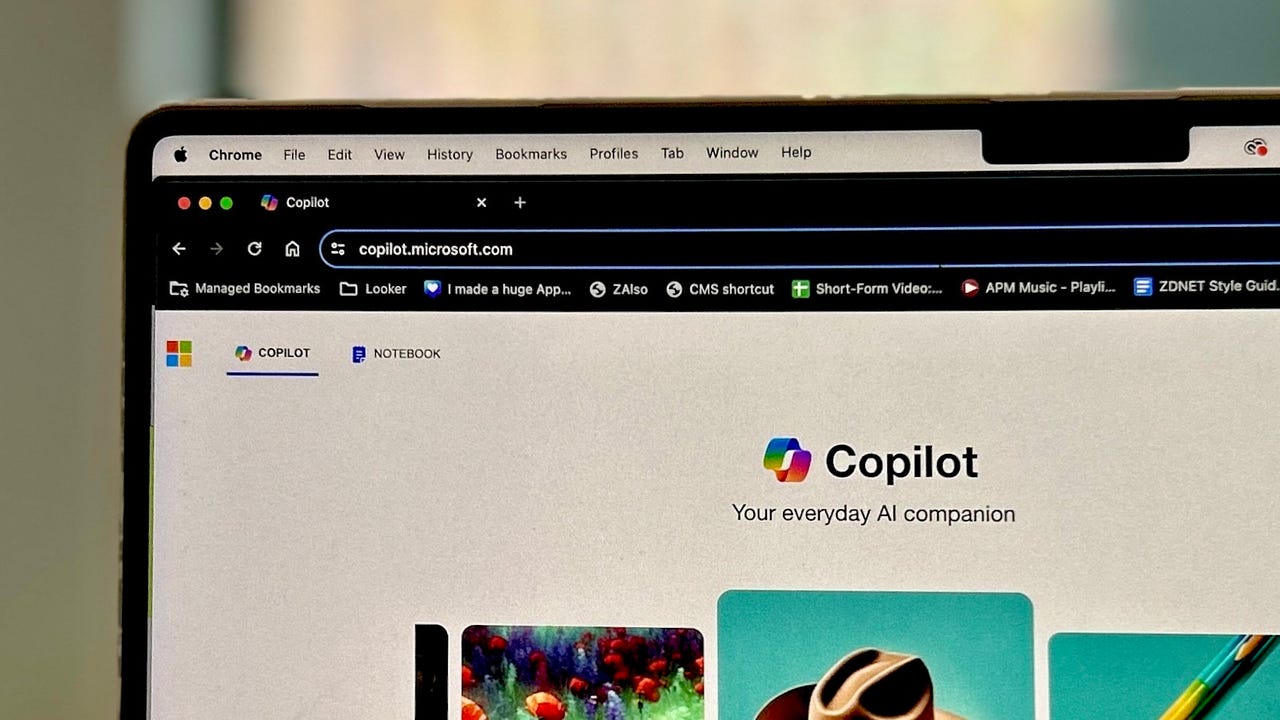
In early February 2023, Microsoft unveiled a new version of its search engine Bing, to compete with ChatGPT. At the time, its standout feature was that the AI chatbot was powered by more advanced technology than ChatGPT, OpenAI’s GPT-4.
At the time of launch, the AI chatbot was called Bing Chat. However, during Microsoft Ignite last November, Microsoft decided to rebrand its chatbot and call it Copilot instead.
Also: How to use Copilot (formerly called Bing Chat)
With Copilot, you can ask the AI chatbot questions and get detailed, human-like responses with footnotes that link back to the sources. Since the chatbot is connected to the internet, it can provide you with up-to-date information.
The chatbot can help you with your creative tasks, such as writing a poem, essay, or song. It can solve complex math or coding tasks, and even generate images from text by using Image Creator from Microsoft Designer within the same platform.
In December last year, Microsoft announced that Copilot would be getting several new features, the most significant being the ability to generate responses using GPT-4 Turbo, OpenAI’s latest model.
Also: Microsoft quietly upgraded Copilot’s free version to GPT-4 Turbo. Here’s why it matters
In March 2024, Microsoft replaced GPT-4 with GPT-4 Turbo in the free version of Copilot. GPT-4 Turbo was anticipated to take the chatbot’s abilities to new limits, with knowledge of world events up to December 2023 and a 128K context window, four times larger than that of GPT-4. In my testing, I found that GPT-4 Turbo did improve the chatbot’s capabilities.
At Microsoft Build, the company’s annual developer conference, the company revealed that GPT-4o is coming to Copilot on Copilot+ PCs. Even though this release doesn’t impact most Copilot users, it is a major upgrade because GPT-4o is OpenAI’s latest multimodal LLM and is impressive.
At Build, the company also announced Team Copilot, meant to act as an assistant for entire teams, with features including Group Collaborator, Meeting Facilitator, and Project Manager, which will all be in preview later this year.
Microsoft has been consistently adding new features to Copilot and sharing those updates via its Bing Blog.
Also: 3 AI features coming to Copilot+ PCs that I wish were on my MacBook
However, to announce major Copilot updates, Microsoft typically waits for a bigger stage, such as a company event like Microsoft Build or Microsoft Ignite. Considering Microsoft Build just took place this week (end of May 2024), it may be at least a few weeks until more updates.
This explainer is constantly updated with the latest news, so it’s a good place to check for the newest updates.
When Microsoft announced Copilot, then called Bing Chat, in February 2023, it said the tool would run on a next-generation OpenAI large language model (LLM) explicitly customized for search.
Microsoft said the next-gen LLM powering the new Bing was faster, more accurate, and “more capable” than ChatGPT or GPT-3.5, the LLM behind ChatGPT at the time.
Also: 5 ways college students can use Copilot for Microsoft 365, starting next month
Five weeks after launching, Microsoft revealed that Bing Chat ran on OpenAI’s latest language model, GPT-4.
Microsoft’s latest upgrade in March 2024 means the free version of Copilot runs on GPT-4 Turbo, OpenAI’s most advanced LLM, and an upgrade from GPT-4. Copilot Pro users, however, can still toggle between the previous LLM — GPT-4 — and GPT-4 Turbo.
Then in May 2024, the company announced that GPT-4o is coming to Copilot on Copilot+ PCs. Of course, this change only impacts Copilot users who purchase one of the newly announced Copilot + PCs.
Like ChatGPT and all AI chatbots, Copilot can help with text queries, including (but not limited to) research, writing assistance, coding, and more. Additionally, it can accept image and voice inputs.
Also: The best AI image generators of 2024: Tested and reviewed
You can use the ability to upload images to learn about any photos you’ve taken. For example, I uploaded an image of my puppy and asked Copilot what breed he was. Within seconds, the tool released an accurate response.
Since its release, the chatbot has undergone a series of chat limit changes. The most recent is a character limit of 120 turns on Copilot.
Also: The best AI chatbots of 2024: ChatGPT and alternatives
Anyone can access Copilot. Just visit the Copilot website and start chatting or sign in with your Microsoft account.
No, you do not need a Microsoft account to access Copilot. You can visit the Copilot website to get started and begin chatting. To get the full Copilot experience, you only need a Microsoft account. Creating an account is free and easy. Visit account.microsoft.com and click ‘Create one’.
You can use Copilot for the same prompts you would use with any other AI chatbot, such as ChatGPT, including the ability to generate new content, such as images, essays, code, text, and more.
Also: I’ve tested a lot of AI tools for work. These are my 5 favorite so far
Copilot can also serve as a more conversational search engine. Since it has access to the internet, Copilot can answer any question you have about current events, history, random facts, and more — concisely and conversationally.
Lastly, Copilot accepts image inputs, which allows you to ask questions and learn more about any image you upload. For example, you can upload a picture of a painting and ask who painted it.
Yes, Copilot is accessible on mobile for iPhone and Android devices via its standalone Copilot app. Users can also access Copilot on mobile via the Bing App. Although the Bing App is not solely dedicated to the chatbot, Copilot can be found in the bottom bar front and center as soon as you open the Bing app.
Microsoft unveiled Copilot Pro, a supercharged subscription version of Copilot, on January 15, 2024.
With the subscription, users get access to a single AI experience across all devices, which gives you better assistance, priority access to the latest models, including OpenAI’s GPT-4 Turbo, enhanced AI image creation, and the ability to create your own Copilot GPTs.
Also: Microsoft Copilot Pro vs. OpenAI’s ChatGPT Plus: Which is worth your $20 a month?
One of the biggest perks is that, if you are a Microsoft 365 Personal and Family subscriber, the Copilot Pro subscription includes access to Copliot in Word, Excel, PowerPoint, Outlook, and OneNote on PC, Mac, and iPad.
The Copilot Pro subscription costs $20 per month per user — the same price as ChatGPT’s premium subscription, ChatGPT Plus, and Google’s Premium AI subscription, Google One AI Premium Plan.
Microsoft was involved with ChatGPT before incorporating the technology into its Bing search engine. The tech giant was an early investor in OpenAI, the AI research company behind ChatGPT, even before ChatGPT was released to the public.
Also: Sam Altman shares the next steps for AI at Microsoft Build
Microsoft’s first involvement with OpenAI was in 2019, when Microsoft invested $1 billion, and then $2 billion in the years after. In January 2023, Microsoft extended its partnership with OpenAI through a multi-year, multi-billion dollar investment.
Neither company disclosed the investment value, but unnamed sources told Bloomberg it would total $10 billion over multiple years. In return, Microsoft’s Azure service will be OpenAI’s exclusive cloud-computing provider, powering all OpenAI workloads across research, products, and API services.
Select users were given early access to the chatbot and were not shy about sharing their experiences. Many of these users tested the chatbot’s capabilities and exposed its varied flaws.
From revealing its confidential codename used internally by developers to declaring its love to a New York Times writer and asking him to leave his wife, the chatbot was acting out of hand.
Also: Microsoft Copilot for Security will move to general availability on April 1
Consequently, Microsoft reeled in the chatbot with a new session limit, changing chat sessions from unlimited to a five-question limit, and a 50-chat turn daily limit. That limit was expanded to six chat turns per session and 60 total chats per day, still less than the original experience users got.
Microsoft noted that convoluted, long chat sessions were not something it was testing for internally, so the public’s feedback was useful in learning more about the chatbot.
“In fact, the very reason we are testing the new Bing in the open with a limited set of preview testers is precisely to find these atypical use cases from which we can learn and improve the product,” said Microsoft.
ZDNET has extensively tested both Copilot and Open AI’s ChatGPT chatbot. Until this month, Copilot earned its spot as ZDNET’s overall best AI chatbot because it solved some of the major problems we had with ChatGPT, including knowledge of current events via internet access and footnotes with links to sources from the information it pulled.
Also: Microsoft unveils Copilot Lab to help users get the most out of its AI assistant
However, in May, OpenAI released several upgrades to ChatGPT that significantly improved the free version of the chatbot and surpassed Copilot’s. Because of ChatGPT’s use of GPT-4o, OpenAI’s most advanced, multimodal LLM, ChatGPT has taken the lead. However, things are always moving so quickly that Copilot may reclaim its top place soon.
On July 18, 2023, Microsoft announced Bing Chat Enterprise, a version of its AI-powered chatbot that is secure and suited to the workplace.
“With Bing Chat Enterprise, user and business data are protected and will not leak outside the organization. What goes in — and comes out — remains protected,” said Microsoft.
Bing Chat Enterprise was rebranded to Copilot in November 2023.
